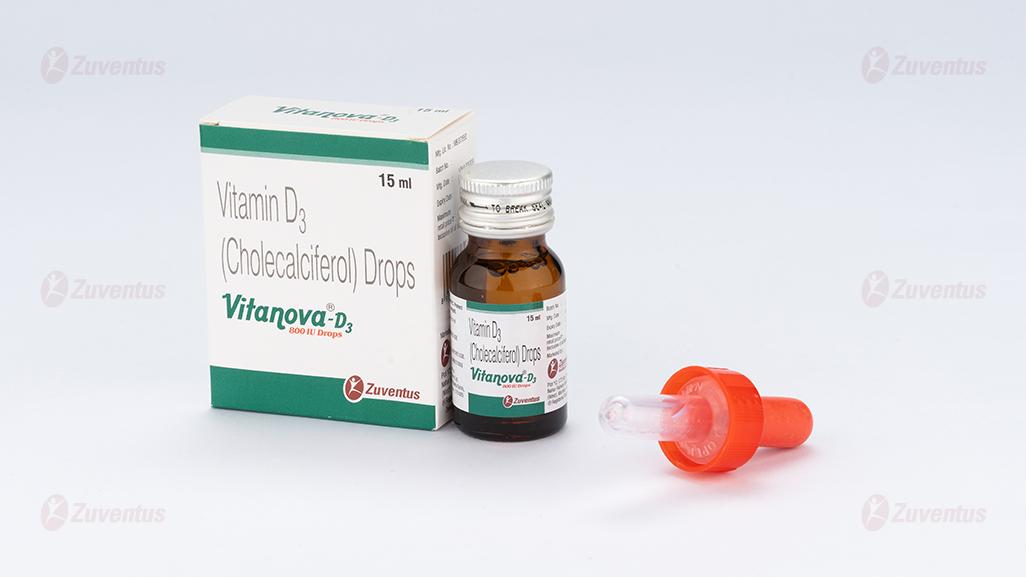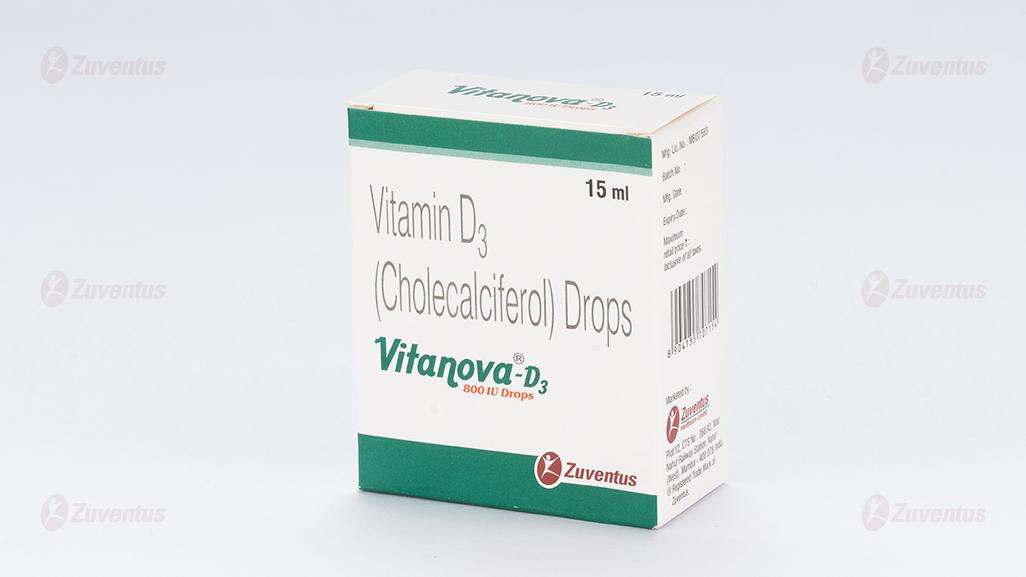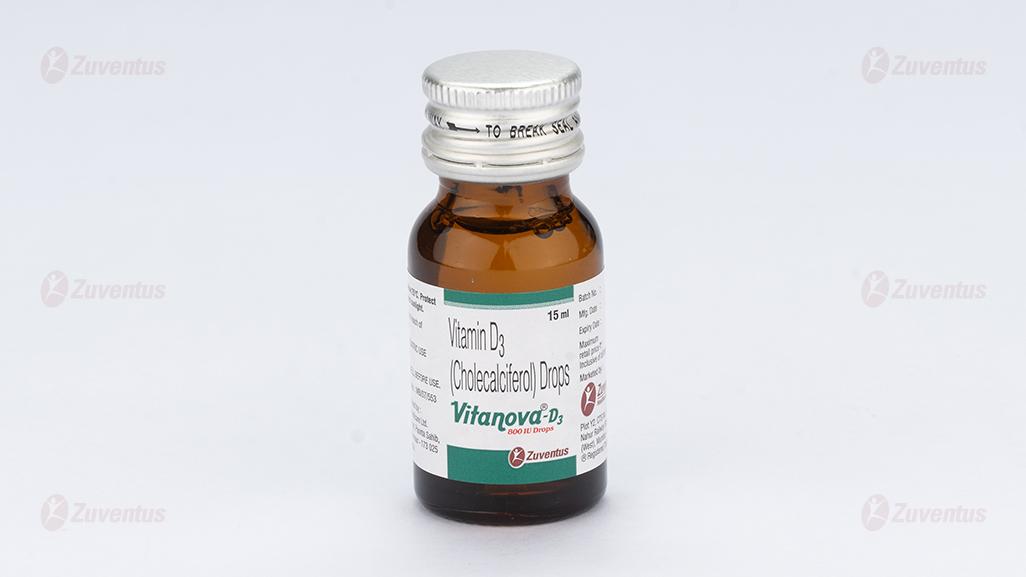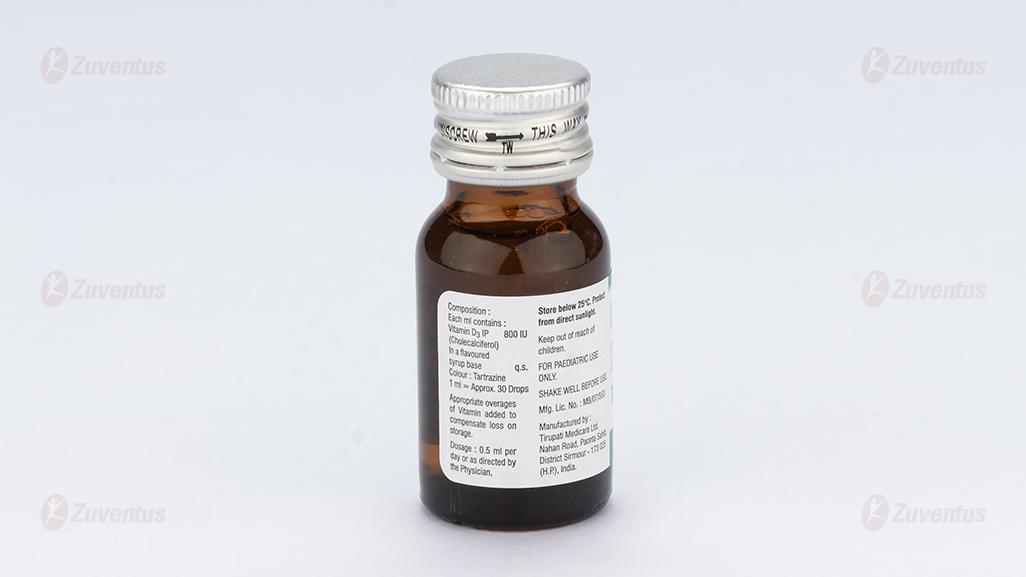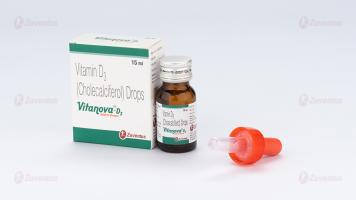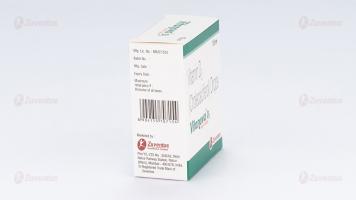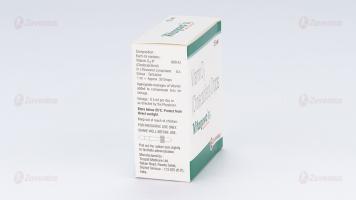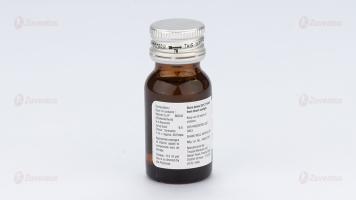Vitanova®-D3 800 IU Drops
1.0 Generic Name
Vitamin-D3 (Cholecalciferol) Drops
2.0 Qualitative and quantitative composition
Each ml contains:
Cholecalciferol IP 800 IU.
In a Flavoured base q.s.
Colour: Tartrazine Supra
Appropriate overages of vitamin added to compensate loss on storage.
3.0 Dosage form and strength
Dosage Form: Oral Drops.
Dosage Strength: 800 IU per ml
4.0 Clinical particulars
4.1 Therapeutic indication
For the treatment of vitamin D3 deficiency
4.2 Posology and method of administration
Treatment vitamin D deficiency should be for up to 12 weeks dependent upon the severity of the disease and the patient's response to treatment, followed by the appropriate long term maintenance therapy.
Pediatric Posology
Infants aged 0 to 2 years
Treatment of vitamin D deficiency: 0.5 ml to 1.25 ml (400 – 1,000 IU) daily.
Long term maintenance therapy following treatment of Deficiency and Prevention of vitamin D deficiency: 0.25ml to 1.25 ml (200 – 1,000 IU) daily.
Children aged 2 years to 11 years
Treatment of vitamin D deficiency: 0.5 ml to 2.5ml (400 – 2,000 IU) daily. Long term maintenance therapy following treatment of deficiency AND Prevention of vitamin D deficiency: 0.5ml to 1.25 ml (400 – 1,000 IU) daily.
Adolescents aged 12 years to 18 years
Treatment of vitamin D deficiency: 0.5 ml – 5ml (400 – 4,000 IU) daily.
Long term maintenance therapy following treatment of deficiency AND Prevention of vitamin D deficiency: 0.5 ml to 2 ml (400 – 1,600 IU) daily.
Adults and the elderly
Treatment of vitamin D deficiency: 1 ml – 5 ml (800 – 4,000 IU) daily. Long term maintenance therapy following treatment of deficiency AND Prevention of vitamin D deficiency: 1 ml – 2 ml (800 – 1,600 IU) daily. As an adjunct to specific therapy for osteoporosis: 1ml (800 IU) daily.
During Pregnancy and Breast-feeding
Treatment of vitamin D deficiency: 1ml – 5ml (800 – 4000 IU) daily.
Long term maintenance therapy following treatment of deficiency: 1ml – 2 ml (800 – 1600 IU) daily.
Table summarising the Posologies of different indications against patient population
| Paediatric posology | Adult posology | ||||
| Infant (0 – 2 years) | Children (2 – 11 years | Adolescents (12 – 18 years) | Adults and elderly | Pregnancy / breast feeding | |
| Treatment | 400 – 1,000 IU/day | 400 – 2,000 IU/day | 400 – 4,000 IU/day | 800 – 4,000 IU/day | 400 – 4,000 IU/day |
| Prevention ( long-term maintenance) | 200 – 1,000 IU/day | 400 – 1,000 IU/day | 400 – 1,600 IU/day | 800 – 1,600 IU/day | 400 IU/day (but up to 2,000) IU/day |
| adjunct to specific therapy for osteoporosis | - | - | - | 800 IU/day | - |
4.3 Contraindications
- Hypersensitivity to vitamin D or any of the excipients in the product
- Hypervitaminosis D
- Nephrolithiasis
- Diseases or conditions resulting in hypercalcaemia and/or hypercalciuria
- Severe renal impairment
4.4 Special warnings and precautions for use
- Vitamin D should be used with caution in patients with impairment of renal function and the effect on calcium and phosphate levels should be monitored. The risk of soft tissue calcification should be taken into account. In patients with severe renal insufficiency, vitamin D in the form of cholecalciferol is not metabolised normally and other forms of vitamin D should be used.
- Caution is required in patients receiving treatment for cardiovascular disease.
- Vitanova- D3 should be prescribed with caution to patients suffering from sarcoidosis because of the risk of increased metabolism of vitamin D to its active form. These patients should be monitored with regard to the calcium content in serum and urine.
- Allowances should be made for vitamin D supplements from other sources.
- The need for additional calcium supplementation should be considered for individual patients. Calcium supplements should be given under close medical supervision.
- Medical supervision is required whilst on treatment to prevent hypercalcaemia.
4.5 Drugs interactions
- Concomitant treatment with phenytoin or barbiturates can decrease the effect of vitamin D because of metabolic activation. Concomitant use of glucocorticoids can decrease the effect of vitamin D.
- The effects of digitalis and other cardiac glycosides may be accentuated with the oral administration of calcium combined with Vitamin D. Strict medical supervision is needed and, if necessary monitoring of ECG and calcium.
- Simultaneous treatment with ion exchange resins such as cholestyramine or laxatives such as paraffin oil may reduce the gastrointestinal absorption of vitamin D.
- The cytotoxic agent actinomycin and imidazole antifungal agents interfere with vitamin D activity by inhibiting the conversion of 25-hydroxyvitamin D to 1,25- dihydroxyvitamin D by the kidney enzyme, 25-hydroxyvitamin D-1-hydroxylase.
4.6 Use in special populations
Pregnancy
There are no or limited amount of data from the use of cholecalciferol in pregnant women. Studies in animals have shown reproductive toxicity. The recommended daily intake for pregnant women is 400 IU, however, in women who are considered to be vitamin D deficient a higher dose may be required. During pregnancy women should follow the advice of their medical practitioner as their requirements may vary depending on the severity of their disease and their response to treatment.
Nursing Mothers
Vitamin D and its metabolites are excreted in breast milk. Overdose in infants induced by nursing mothers has not been observed, however, when prescribing additional vitamin D to a breast-fed child the practitioner should consider the dose of any additional vitamin D given to the mother.
Infants
Vitamin D3 should be used with caution in infants, who may have increased sensitivity to its effects.
Geriatric Patients
Elderly patients may be given the same dose as recommended for adults. However, studies have shown that the elderly people may have greater requirement for vitamin D due to a possible decrease in the capacity of skin to produce pro-vitamin D3, or a decrease in exposure to the sun, or impaired renal function, or impaired vitamin D absorption.
Renal impairment
Cholecalciferol should be used with caution in patients with renal impairment and the effect on calcium and phosphate levels should be monitored. The risk of soft tissue calcification should be taken into account. In patients with severe renal impairment cholecalciferol is not metabolized normally thus, another form of vitamin D should be used. Use of cholecalciferol is contraindicated in patients with severe renal impairment.
Hepatic Impairment
Liver disease may impair the absorption of cholecalciferol. Thus, cholecalciferol should be used with caution in patients with hepatic impairment.
4.7 Effects on ability to drive and use machines
Vitanova-D3 has no influence on the ability to drive and use machines.
4.8 Undesirable effects
Adverse reactions are listed below, by system organ class and frequency. Frequencies are defined as: uncommon (>1/1,000, <1/100) or rare (>1/10,000, <1/1,000).
Metabolism and nutrition disorders
Uncommon: Hypercalcaemia and hypercalciuria. Skin and subcutaneous disorders
Rare: Pruritus, rash and urticaria.
Reporting of suspected adverse reactions
- Reporting suspected adverse reactions after authorisation of the medicinal product is important. It allows continued monitoring of the benefit/risk balance of the medicinal product. Healthcare professionals are asked to report any suspected adverse reactions via email to: medico@zuventus.com
- Website: http://www.zuventus.co.in/safety.aspx
By reporting side effects, you can help provide more information on the safety of this medicine.
4.8 Overdose
The most serious consequence of acute or chronic overdose is hypercalcaemia due to vitamin D toxicity. Symptoms may include nausea, vomiting, polyuria, anorexia, weakness, apathy, thirst and constipation. Chronic overdoses can lead to vascular and organ calcification as a result of hypercalcaemia.
Symptoms:
Acute or chronic overdose of vitamin D can cause hypercalcaemia. Symptoms of hypercalcemia are tiredness, psychiatric symptoms (e.g., euphoria, dazedness, disturbed consciousness), nausea, vomiting, lack of appetite, weight loss, thirst, polyuria, formation of renal calculi, nephrocalcinosis, extraosseous calcification and kidney failure, changes in ECG, arrhythmias, and pancreatitis. In isolated cases their course has been described as fatal.
Treatment:
If a massive dose has been ingested ventricular emptying may be considered, together with the administration of carbon. Sunlight and further administration of vitamin D or calcium should be avoided. Rehydration and treatment with diuretics, e.g. furosemide to ensure adequate diuresis. In hypercalcemia biphosphonates or calcitonin and corticosteroids may be given. The treatment is directed to symptoms.
5.0 Pharmacological properties
5.1 Mechanism of Action
The mechanism of action of 1,25(OH)2D(calcitriol) is mediated by the interaction of calcitriol with the vitamin D receptor (VDR). Calcitriol binds to cytosolic VDRs within target cells, and the receptor-hormone complex translocates to the nucleus and interacts with DNA to modify gene transcription. The VDR belongs to the steroid and thyroid hormone receptor supergene family. Calcitriol also exerts nongenomic effects that may require the presence of a functional VDR.
5.2 Pharmacodynamic properties
Vitamin D3 is converted to 25hydroxyvitamin D3 in the liver. Conversion to the active calcium-mobilizing hormone 1, 25-dihydroxyvitamin D3 (calcitriol) in the kidney is stimulated by both parathyroid hormone and hypophosphatemia. The principal action of 1,25dihydroxyvitamin D3 is to increase intestinal absorption of both calcium and phosphate as well as regulate serum calcium, renal calcium and phosphate excretion, bone formation and bone resorption.
Vitamin D is required for normal bone formation. Vitamin D insufficiency develops when both sunlight exposure and dietary intake are inadequate. Insufficiency is associated with negative calcium balance, increased parathyroid hormone levels, bone loss, and increased risk of skeletal fracture. In severe cases, deficiency results in more severe hyperparathyroidism, hypophosphatemia, proximal muscle weakness, bone pain and osteomalacia.
5.3 Pharmacokinetic properties
Absorption
Vitamin D substances are well absorbed from the gastrointestinal tract. The presence of bile is essential for adequate intestinal absorption; absorption may be decreased in patients with decreased fat absorption.
Distribution
Vitamin D and its metabolites circulate in the blood, bound to a specific alpha-globulin. Vitamin D can be stored in adipose and muscle tissue for long periods of time. It is slowly released from such storage sites and from the skin where it is formed in the presence of sunlight or ultraviolet light. Cholecalciferol has a slow onset and a long duration of action.
Metabolism
Cholecalciferol is converted in the liver by hydroxylation to the active form 25-hydroxycholecalciferol. It is then further converted in the kidneys to 1,25-dihydroxycholecalciferol. 1,25-dihydroxycholecalciferol is the metabolite responsible for increasing calcium absorption. Vitamin D that is not metabolized is stored in adipose and muscle tissues.
Excretion
Vitamin D compounds and their metabolites are excreted mainly in the bile and faeces, with only small amounts appearing in the urine. There is some enterohepatic recycling but it is considered to have a negligible contribution to vitamin D status. Certain vitamin D substances may be distributed into breast milk.
6.0 Nonclinical properties
6.1 Animal Toxicology or Pharmacology
Vitamin D is well known and is a widely used material and has been used in clinical practice for many years. As such toxicity is only likely to occur in chronic overdosage where hypercalcaemia could result.
Cholecalciferol has been shown to be teratogenic in high doses in animals (4-15 times the human dose). Offspring from pregnant rabbits treated with high doses of vitamin D had lesions anatomically similar to those of supravalvular aortic stenosis and offspring not showing such changes show vasculotoxicity similar to that of adults following acute vitamin D toxicity.
7.0 Description
Vitanova D3 contains cholecalciferol (Vitamin D3). Vitamin D3 is essential for the proper growth and development of the body. It is synthesized within the body after exposure to sunlight and is essential for many important functions of the human body. Vitamin D3 in Vitanova D3 also increases the Calcium absorption from the intestines. Chemical name- (1S,3Z)-3-[(2E)-2-[(1R,3aS,7aR)-7a-methyl-1-[(2R)-6-methylheptan-2-yl]-2,3,3a,5,6,7-hexahydro-1H-inden-4-ylidene]ethylidene]-4-methylidenecyclohexan-1-ol
Chemical formula- C27H44O
Molecular weight- 384.6.
8.0 Pharmaceutical particulars
8.1 Incompatibilities
Not applicable.
8.2 Shelf-life
24 months.
8.3 Packaging information
Amber-coloured bottle glass (15 mL) with silver cap and dropper.
8.4 Storage and handing instructions
Store below 25°C. Keep out of reach of children.
Any unused product should be disposed of in accordance with local requirements.
9.0 Patient Counselling Information
Take exactly as directed by your doctor or on the label. Do not increase the dosage or take for longer than is recommended.
Instruct patients on the following points when administering the drug. Inform the patient not to take Cholecalciferol if they have
- allergic to vitamin D or any of the other ingredients of this medicine
- high levels of vitamin D in your blood
- kidney stones or serious kidney problems
- high levels of calcium in your blood and/or urine
Remind patients to inform their healthcare provider immediately before taking Cholecalciferol if they have
- problems with kidneys
- sarcoidosis
- they are already taking other medicines or supplements containing vitamin D.
Read all of this leaflet carefully before you start using this medicine, because it contains important information for you.
-Keep this leaflet. You may need to read it again.
-If you have any further questions, ask your doctor, or pharmacist, or nurse.
-This medicine has been prescribed for you only. Do not pass it on to others. It may harm them, even if their signs of illness are the same as yours.
-If you get any side effects, talk to your doctor, or pharmacist, or nurse. This includes any possible side effects not listed in this leaflet. See section 4
What is in this leaflet
1.What Vitanova®-D3 is and what it is used for
2.What you need to know before you use Vitanova®-D3
3.How to use Vitanova®-D3
4.Possible side effects
5.How to store Vitanova®-D3 Contents of the pack and other information
1.0 What Vitanova®-D3 is and what it is used for
Vitanova®-D3 800 IU Drops contains Cholecalciferol (vitamin D3). Vitamin D3, is found in some foods and is mainly produced by the body when skin is exposed to sunlight. Vitamin D3 helps the kidneys and intestine absorb calcium and it helps build bones. Vitamin D3 deficiency is the predominant cause of rickets (defective mineralization of bones in children) and osteomalacia (inadequate mineralization of bones in adults).
Vitanova®-D3 800 IU Drops, may be prescribed by your doctor to prevent and treat vitamin D3 deficiency in adults, adolescents and children with an identified risk of vitamin D deficiency. Vitamin-D deficiency may occur when your diet and lifestyle does not provide you enough Vitamin-D or when your body requires more Vitamin- (pregnancy). It may also be prescribed in for certain bone conditions such as thinning of bones (osteoporosis) when it is given with other medications.
2.0 Before you take Vitanova®-D3
Do not take Vitanova®-D3 if you
- are allergic (hypersensitive) to vitamin D or any of the other ingredients in the drops (these are listed in section 6, Further information)
- have high levels of vitamin D in your blood (hypervitaminosis D)
- have high blood levels of calcium (hypercalcaemia) or high urine levels of calcium (hypercalciuria)
- have kidney stones or serious kidney problems.
Check with your doctor before taking Vitanova®-D3 if
- You have kidney damage or disease. Your doctor may want to measure the levels of calcium in your blood or urine You are being treated for heart disease
- You have sarcoidosis (an immune system disorder which may affect your liver, lungs, skin or lymph nodes)
- You are already taking additional doses of calcium or vitamin D. Whilst you are taking Vitanova®-D3 drops your doctor will monitor your blood levels of calcium to make sure they are not too high.
Taking other medicines
Please tell your doctor or pharmacist if you are taking or have recently taken any other medicines, including medicines obtained without a prescription.
In particular, the following medicines may interact with Vitanova®-D3
- Heart medicines (cardiac glycosides such as digoxin). Your doctor may monitor your heart with an electrocardiogram (ECG) and measure the levels of calcium in your blood.
- Medicines to treat epilepsy (such as phenytoin) or medicines to make you sleep (barbiturates such as phenobarbitone) as these medicines can decrease the effect of vitamin D.
- Glucocorticoids (steroids hormones such as hydrocortisone or prednisolone). These can decrease the effect of vitamin D.
- Laxatives (such as paraffin oil) or a cholesterol lowering drug called colestyramine may reduce the absorption of vitamin D.
- Actinomycin (a medicine used to treat some forms of cancer) and imidazole antifungals (medicines such as clotrimazole and ketoconazole used to treat fungal diseases) as they may interfere with the metabolism of vitamin D.
Taking Vitanova®-D3 with food and drink
You can take Vitanova®-D3 with or without food and drink.
Pregnancy and breast-feeding
If you are pregnant or think you may be pregnant or you are breast-feeding, you should talk to you doctor or pharmacist before you take Vitanova®-D3 Drops. Vitanova®-D3 Drops should be used during pregnancy and breast-feeding only if recommended by your doctor.
Driving and using machines
Vitanova®-D3 drops should not affect your ability to drive or operate machinery.
3.0 How to take Vitanova®-D3
Always take Vitanova®-D3 exactly as your doctor has told you. The drops should be dispensed onto a spoon before taking.
Dose
Use in children and adolescents
Infants aged 0 up to 2 years’ old
To treat vitamin D deficiency: Your doctor will usually prescribe 0.5 to 1.25ml daily for up to 12 weeks, followed by a long term maintenance dose.
Long term maintenance and to prevent vitamin D deficiency: Your doctor will usually prescribe 0.25ml to 1.25 ml daily.
Children aged 2 years to 11 years old
To treat vitamin D deficiency: Your doctor will usually prescribe 0.5 ml to 2.5 ml daily for up to 12 weeks, followed by a long term maintenance dose.
Long term maintenance and to prevent vitamin D deficiency: Your doctor will usually prescribe 0.5 ml to 1.25 ml daily.
Adolescents aged 12 years to 18 years old
To treat vitamin D deficiency: Your doctor will usually prescribe 0.5 ml to 5 ml daily for up to 12 weeks, followed by a long term maintenance dose.
Long term maintenance and to prevent vitamin D deficiency: Your doctor will usually prescribe 0.5 ml to 2 ml daily.
In infants, children and adolescents the drops can be mixed with a small amount of children’s foods, yogurt, milk, cheese or other dairy products. The drops must not be mixed into a bottle of milk or container of soft foods in case the child does not consume the whole portion, and so does not then receive the full dose.
Use in adults and the elderly
To treat vitamin D deficiency: your doctor will usually prescribe 1 to 5 ml daily for up to 12 weeks, followed by a long term maintenance dose.
Long term maintenance and to prevent vitamin D deficiency: Your doctor will usually prescribe 1 to 2 ml daily.
In osteoporosis (you will also be taking other medicines for this): Your doctor will usually prescribe 1 ml daily.
Use in pregnancy and breast-feeding
To treat vitamin D deficiency: Your doctor will usually prescribe 1 to 5 ml daily for up to 12 weeks, followed by a long term maintenance dose.
Long term maintenance and to prevent vitamin D deficiency: Your doctor will usually prescribe 1 ml to 2 ml daily.
In adults, the drops can be mixed with a small amount of cold or lukewarm food immediately before taking.
You should check with your doctor or pharmacist if you are unsure.
If you take more Vitanova®-D3 than you should
If you accidentally take one drop too many, nothing is likely to happen. If you accidentally take several drops too many tell your doctor or get other medical advice immediately. If possible, take the bottle, the box and this leaflet with you to show the doctor. If you take too many drops you may feel or be sick, become constipated or have stomach pains, weak muscles, tiredness, lack of appetite, kidney problems and in severe cases irregular heartbeats.
If you forget to take Vitanova®-D3
If you forget to take your drops, take them as soon as you can. Do not take a double dose to make up for a forgotten dose. After that, take the next dose in accordance with the instructions given to you by your doctor.
If you have any further questions on the use of this product, ask your doctor or pharmacist.
4.0 Possible side effects
Like all medicines, Vitanova®-D3 can cause side effects, although not everybody gets them.
Side effects with Vitanova®-D3 may include:
Uncommon side effects
(affecting less than 1 in 100 people)
- Too much calcium in your blood (Hypercalcaemia). You may feel or be sick, loose your appetite, have constipation, stomach ache, feel very thirsty, have muscle weakness, drowsiness or confusion
- Too much calcium in your urine (hypercalciuria).
Rare side effects
(affecting less than1 in 1000 people)
- Skin rash
- Itching
- Hives
Reporting of side effects
If you get any side effects, talk to your doctor. This includes any possible side effects not listed in this leaflet. You can also report side effects directly: Website: www.zuventus.co.in and click the tab “Safety Reporting” located on the top of the home page.
By reporting side effects, you can help provide more information on the safety of this medicine.
5.0 How to store Vitanova®-D3
Keep out of the sight and reach of children.
Store below 25ºC.
Do not used Vitanova®-D3 after the expiry date which is stated on the carton as “EXP”. The expiry date refers to the last day of that month.
Opened bottle should be used within 6 months.
Medicines should not be disposed or via wastewater or household waste. Ask your pharmacist how to dispose of medicines no longer required. These measures will help to protect the environment.
6.0 Contents of the pack and other information
What VITANOVA- D3 oral drops contains
Each ml contains:
Cholecalciferol IP 800 IU.
In a Flavoured base q.s.
Colour: Tartrazine Supra
Appropriate overages of vitamin added to compensate loss on storage.
What VITANOVA- D3 looks like and contents of pack
Amber-coloured bottle glass (15 mL) with silver cap and dropper.
Packaging: A bottle of 15 ml

